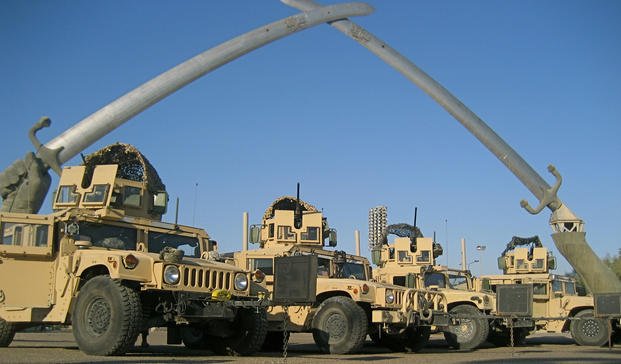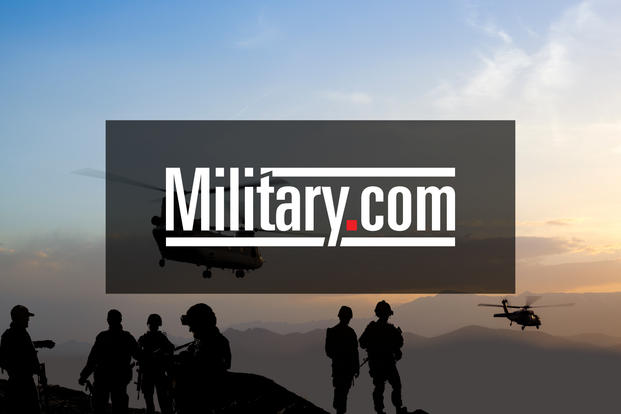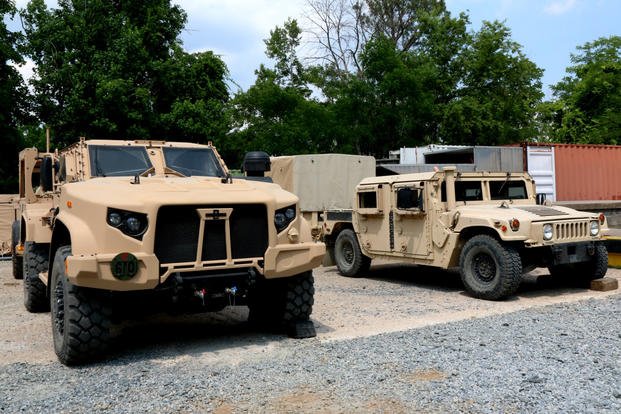Army and Marine Corps combat units are starting to receive brand-new, high-performance Joint Light Tactical Vehicles. But if war with a major power ignites in the near future, the bulk of U.S. ground forces will go into battle with the same Humvees that struggled to survive the last war.
Today, the formidable-looking JLTV – which promises vastly improved crew protection and enhanced performance – is ready for battle. But it will take the military more than a decade to field roughly 58,000 of them to the Army and the Marines.
Even then, tens of thousands of Humvees will remain in service.
The Army hasn't decided whether it will upgrade its existing Humvees with improved protection and performance, a move the Marines have decided against. While there are risks associated with leaving the Humvee as it currently is, military experts question whether a major war with Russia or China will present threats that the vehicle can't handle. As policy makers push for more armor and greater survivability on all platforms, some say military leaders must make the choice to be honest with the American public about the reality of warfare: that too much armor protection can hinder performance and that ground troops will die no matter what vehicle carries them into battle.
The venerable Humvee was first fielded to combat units in the mid-1980s. It had impressive mobility; it was fast and extremely reliable.
But beginning in 2004, the vehicle that was designed for the European battlefield began to struggle when it faced a determined Iraqi insurgency that fought with improvised explosive devices, or IEDs. Soon, images of burnt-out, twisted Humvees became a symbol of America's struggle to cope with a new, horrific type of warfare.
While many short-term efforts to protect troops were launched, the Pentagon was determined to develop a lasting solution. It first approved the JLTV as a program of record in 2006.
U.S. military leaders are eager to tout the JLTV program as a success story, but seem reluctant and uncertain regarding how the Humvee will be used alongside the new vehicle in future warfare.
In September, Marine Corps Commandant Gen. Robert Neller acknowledged to Military.com that the "Humvee is going to be around for a while," but said where they are used will depend on "what the threat is."

"Obviously, you have concerns about any lightly armored vehicle and what the adversary might have, as far as direct fire and even indirect fire, IEDs and mines," Neller said. "We are not going to put any Marine in a vehicle in an environment that we don't think they have a great chance of accomplishing the mission and being survivable at the same time."
Since then, the Army and Marine Corps have declined formal interview requests from Military.com to discuss the future of the Humvee.
The Army's plans to purchase and field just over 49,000 JLTVs "extend into the mid-2030s," spokesman Lt. Col. Isaac Taylor told Military.com.
Those Humvees not replaced by JLTVs will make up the remaining bulk of the Army's light tactical vehicle, or LTV, requirement of 117,000 vehicles.
"The objective of the Army's light tactical wheeled vehicle (LTV) strategy is to enhance survivability of soldiers," Taylor said. "The Army's primary goal is to transition to an LTV fleet that is capable of scaleable protection for existing vehicles, while simultaneously investing in new, more modern vehicles. The JLTV is the next-generation LTV, designed to provide increased protection, performance and payload."
The Marine Corps currently plans to buy roughly 9,000 JLTVs – an increase over its original purchase plan of 5,500 – and field them "through the 2020s," according to a statement to Military.com from Marine Corps Capabilities Development Directorate.
"The total number of [Humvees] we have now will not be replaced by JLTVs," according to the statement, which added that the overall Marine Humvee "requirements are less now than they were a decade ago."
For operational security reasons, Marine officials would not reveal how many Humvees the service currently has. But the 9,000 JLTVs fielded over the next decade will replace about 60 percent of the Humvee fleet, according to the statement.
Discussing the Humvee is likely a sensitive subject with the services because of the political backlash military leaders had to endure in the early days of Operation Iraqi Freedom, when Humvees where being blown up on a daily basis.

According to Defense Department numbers, 3,481 U.S. service members were killed in Operation Iraqi Freedom through the entire conflict, a relatively low number compared to past U.S. wars.
But beginning in 2004, soldiers who survived IED attacks often came home missing arms, legs and sometimes faces – a reality that enraged members of Congress and led to many emotional hearings in which lawmakers accused military leaders of failing to provide adequate battlefield protection to deploying U.S. service members.
"The problem comes down to a disconnect between current understanding of war, expectations of war, and the reality of war – not only among the American public but certainly here on Capitol Hill, among members of Congress and even members of the military," said Dakota Wood, a retired Marine Corps lieutenant colonel and now a senior research fellow at The Heritage Foundation.
"Why was everybody caught by surprise when the enemy used landmines – you know, roadside bombs, IEDs – why was it a surprise when the enemy used explosives to blow up vehicles carrying American soldiers?" Wood asked, arguing the Humvee, made by AM General LLC, was never designed to survive blasts capable of destroying a tank. "And yet, when this started occurring on the battlefield, you would have thought we had already lost the war, that the military was negligent in providing adequate protection."
Under extreme pressure from Congress, the military overloaded the lightweight Humvee with armor and, in 2007, launched a $47 billion program to field much heavier, Mine-Resistant Ambush Protected vehicles to protect troops.
MRAPs, while effective, sometimes weighed more than 20 tons, making them too heavy and slow-moving for many battlefield situations.
It took almost a decade for the JLTV to become a reality but, in August 2015, Oshkosh Corp. was selected over Lockheed Martin Corp. and AM General LLC to build the JLTV for the Army and the Marine Corps, a program that could exceed $30 billion to meet the current joint-service requirement.
The JLTV offers increased crew protection, such as MRAP-like underbelly blast protection, blast-protected seats, restraints and technologies designed to absorb and deflect blast -- while still meeting the Army's on- and off-road performance requirements.
The Army is currently studying whether to make additional improvements to the Humvee beyond the upgrades that went into the expanded-capacity vehicle, or ECV, Humvees such as the newer M1151A1 ECV Armament Carrier.
"The service recently conducted a study of Infantry Brigade Combat Team (IBCT) vehicle requirements and will conduct an additional evaluation of a mixed fleet of [Humvees] and JLTVs in FY22 or earlier," Taylor said.
The Corps does not intend to upgrade its existing Humvee fleet, according to the Marine statement, which added that the Humvee fleet "will be managed and maintained in a high state of readiness by disposing of our least ready vehicles at the earliest opportunity as JLTVs are fielded. Those [Humvees] remaining in the inventory will be maintained through normal organic and depot maintenance procedures until they are replaced."
To retired Army Maj. Gen. Robert Scales, the Humvee doesn't need upgrading to go to war with an adversary such as Russia.
"In a European scenario, for which the Humvee was designed, it's perfectly fine," said Scales, a Vietnam veteran who is currently a key adviser to the Defense Department's Close Combat Lethality Task Force.
Scales remembers that he was an assistant division commander with the 2nd Infantry Division in Korea when the Humvee was first fielded.
"The whole division was equipped with Humvees. Given the terrain in Korea, and given the North Korean threat, it was fine," he said.
It's unlikely that a future war with Russia or China will involve IEDs like the ones used in Iraq, Scales said.
"The issue with the Russians is not stuff on the ground, it's stuff flying through the air -- the surface-to-surface threat from Russia and, I would presume, China as well," he said. "So what is important for a vehicle in that type of strike-counterstrike environment is the ability to displace quickly, to be small and difficult to spot and to be able to move about the battlefield to avoid strike and counterstrike."
Wood said retrofitting existing Humvees with additional protection, as well as enhancing the suspension, engine and other key features to increase performance, will be expensive and increase the weight of the vehicle.
"If I increase armor, I am going to increase weight, which means the trafficability and transportability become more difficult," he said. "If I increase the size, power, weight and armor that incorporate a JLTV, cost is going to go up.
"People get upset when war costs a lot of money, but then, when you don't spend the money, you are also criticized for not protecting the force and providing the military what it needs to win in combat. You can't have it both ways," Wood said.
Scales agreed that the Humvee wasn't designed to be a JLTV.
"It wasn't designed for that. Now remember, in Europe you are going to be – at least in the battlefields that were postulating in central Europe – you are going to be maneuvering hundreds of kilometers. And what is important is fuel efficiency and reliability, and when you start slapping armor in the sides of Humvees…you are going to pay a price for that," he said.
The JLTV, Scales said, "is designed from the ground up" for missions where more armor protection is needed.
"The key is to concentrate those at the tip of the spear, where their utility for close combat can be fully exploited," he said.
Wood said he believes the current Humvee is still "very capable."
"Today's Humvee fleet is doggone pretty good. It's going to meet 80 percent of the requirements most of the time. You don't need everything to be fully up-armored," he said.
"But sure as shooting…we will deploy a force, some set of soldiers are going to be moving from point A to point B in a less-than-heavily armored Humvee," Wood added. "They are going to get hit with a rocket-propelled grenade or some kind of armor-piercing, incendiary round or road-side bomb, and they will get blown up. And that's where the news is going to carry, and that is when Congress and the media will pounce all over the military about how could you have sent our guys and gals in harm's way inappropriately equipped. There is no perfect solution, and I think Congress just needs to understand that."
-- Matthew Cox can be reached at matthew.cox@military.com.












